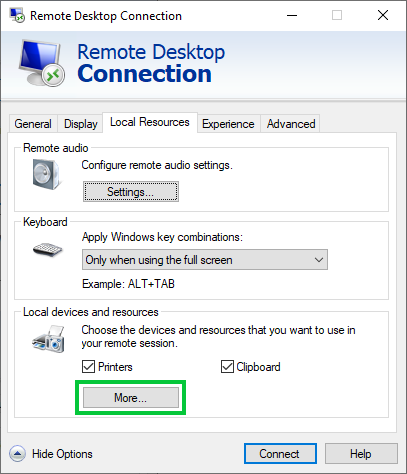Use Remote Desktop on your Windows, Android, or iOS device to connect to a Windows 10 PC from afar.

- Mstsc.exe is the built-in client software which allows connecting to a computer via Remote Desktop Protocol (RDP). It is a special network protocol which allows a user to establish a connection between two computers and access the Desktop of a remote host. The local computer is often referred to as the 'client'.
- In Remote Desktop Connection, type the name of the PC you want to connect to (from Step 1), and then select Connect. On your Windows, Android, or iOS device: Open the Remote Desktop app (available for free from Microsoft Store, Google Play, and the Mac App Store), and add the name of the PC that you want to connect to (from Step 1).
Apr 01, 2021 Iperius Remote is one of the easiest to use remote desktop programs with some awesome features like a robust file transfer tool and chat application. It also lets you connect to a computer remotely with their mobile app. Open the program and select Allow connections to see your password. Share that and the ID next to it with the. Using an RDP connection file you can set the alternate shell to be your application; the file syntax is like. Alternate shell:s:c: winnt system32 otepad.exe and you pass that as a command-line argument to mstsc.exe; this similar to chrissr's solution, but without affecting every RDP session you launch. A fuller summary of settings here. First published on CloudBlogs on Jun, 08 2009 Since the debut of RemoteApp in Windows Server 2008, Windows users have been able to enjoy remote applications with the same look and feel as local applications. RemoteApp and Desktop Connections is a new feature in Windows 7 and Windows Server 2008 R2.

Set up the PC you want to connect to so it allows remote connections:
Make sure you have Windows 10 Pro. To check, go to Start > Settings > System > About and look for Edition. For info on how to get it, go to Upgrade Windows 10 Home to Windows 10 Pro.
When you're ready, select Start > Settings > System > Remote Desktop, and turn on Enable Remote Desktop.
Make note of the name of this PC under How to connect to this PC. You'll need this later.
Use Remote Desktop to connect to the PC you set up:
On your local Windows 10 PC: In the search box on the taskbar, type Remote Desktop Connection, and then select Remote Desktop Connection. In Remote Desktop Connection, type the name of the PC you want to connect to (from Step 1), and then select Connect.
On your Windows, Android, or iOS device: Open the Remote Desktop app (available for free from Microsoft Store, Google Play, and the Mac App Store), and add the name of the PC that you want to connect to (from Step 1). Select the remote PC name that you added, and then wait for the connection to complete.
Virtualization and remote desktops are an important part of your infrastructure and work. And, we recommend that you use Windows built-in Remote Desktop Connection (%windir%system32mstsc.exe) or universal Remote Desktop client instead of Remote Desktop Connection Manager (RDCMan).
Original product version: Windows 10 - all editions
Original KB number: 4512838
More information
Mstsc App Online


We're increasing our investments in virtualization and remote desktops, such as Windows Virtual Desktop and RDS on Microsoft Azure.
RDCMan is a client that is widely used to manage multiple remote desktop connections because it's a convenient option. However, RDCMan has not kept pace with the level of advanced technology that we're pursuing.
Remote Desktop Connection Manager Sysinternals
Instead, we have two great supported client options: Remote Desktop Connection and Universal Client for Windows 10. These clients offer increased security, and they are a key part of our engineering roadmap moving forward. In the future, you can expect even more capabilities, such as the ability to better manage multiple connections.
